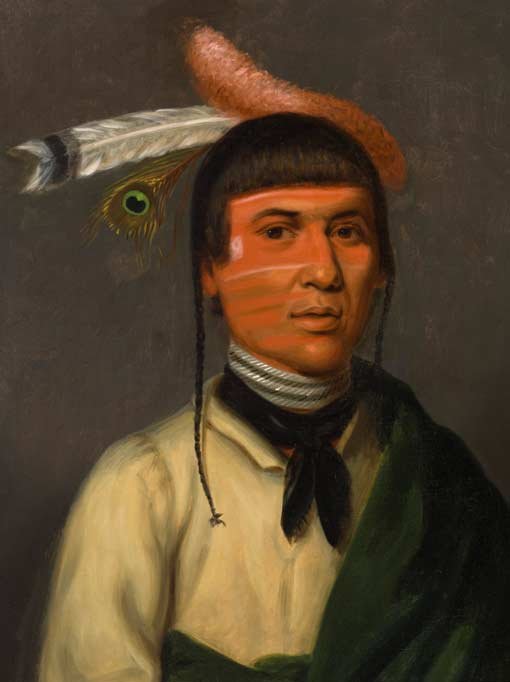Introduction

Focus work
Henry Inman
No-Tin (Wind), a Chippewa Chief 1832–33
Los Angeles County Museum of Art, gift of the 2008 Collectors Committee, photo: Museum Associates/LACMA
In 1822, Thomas L McKenney, head of the US Bureau of Indian Affairs, commissioned Charles Bird King to make portraits of Native American chiefs. Henry Inman’s copies of these portraits were later used to promote the collection. James Barbour, head of the War Department, endorsed the project, believing ‘that this race was about to become extinct’. Threats to the Ojibwa (Chippewa) included frontier conflict, alcohol and over-hunting prompted by fur traders. Today over 170,000 US citizens identify themselves as Ojibwa.
McKenney met No-Tin in Washington, DC in 1824 and again at Fond du Lac, Wisconsin in 1826 during treaty negotiations. He described No-Tin as ‘an active, intelligent, smart Indian. A good hunter and a brave warrior’. McKenney kept a portrait of No-Tin – ‘a good-looking chief’ – in his office.
Issues for discussion
Does this painting show an accurate interpretation of the sitter? What has the artist tried to capture? How do you think different audiences would respond to this image: Australians compared to Americans, Ojibwa people compared to others, viewers of today compared to those of the time the portrait was painted? Discuss similarities and differences in the responses as well as the importance of the audience adding a layer of meaning to the work.
Artist biography
Henry Inman moved to New York City with his family when he was 12. In his teens he secured an apprenticeship with prominent portrait painter John Wesley Jarvis, with whom he trained between 1814 and 1821. During this period Inman began to specialise in miniature portraits. On completing his training he opened his own studio and began tutoring George Twibill and Thomas Seir Cummings in portraiture and miniature painting. By 1826 Inman and Cummings had formed a professional partnership; working collaboratively, they were able to produce several portraits a week. Their working relationship continued when they both played major roles in the establishment of the National Academy of Design, New York in 1825, Inman serving as its first vice-president. In the following years Inman earned a reputation as a portraitist and was commissioned by wealthy families and local government to produce portraits that would eventually be reproduced for print. In 1831 he moved to Philadelphia to partner with engraver Cephas G Childs in the lithographic firm Childs & Inman. Returning to New York in 1834, Inman enjoyed continued financial success until the economic recession of 1837. Despite health and monetary complications, Inman continued to paint and visited England in 1844 to paint commissioned portraits of William Wordsworth and Thomas Macaulay, dying shortly after his return to New York in 1846.
More information
Los Angeles County Museum of Art website